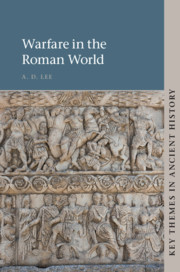Refine search
Actions for selected content:
15418 results in Military history
Glossary
-
- Book:
- Warfare in the Roman World
- Published online:
- 04 September 2020
- Print publication:
- 17 September 2020, pp 191-193
-
- Chapter
- Export citation
Chapter 2 - Military Service and Courage
-
- Book:
- Warfare in the Roman World
- Published online:
- 04 September 2020
- Print publication:
- 17 September 2020, pp 53-69
-
- Chapter
- Export citation
Maps and Illustrations
-
- Book:
- Warfare in the Roman World
- Published online:
- 04 September 2020
- Print publication:
- 17 September 2020, pp xi-xii
-
- Chapter
- Export citation
Copyright page
-
- Book:
- Warfare in the Roman World
- Published online:
- 04 September 2020
- Print publication:
- 17 September 2020, pp vi-vi
-
- Chapter
- Export citation
Table of Significant Events
-
- Book:
- Warfare in the Roman World
- Published online:
- 04 September 2020
- Print publication:
- 17 September 2020, pp 185-187
-
- Chapter
- Export citation
Contents
-
- Book:
- Warfare in the Roman World
- Published online:
- 04 September 2020
- Print publication:
- 17 September 2020, pp ix-x
-
- Chapter
- Export citation

Warfare in the Roman World
-
- Published online:
- 04 September 2020
- Print publication:
- 17 September 2020
Dedication
-
- Book:
- Sisters in Arms
- Published online:
- 31 August 2020
- Print publication:
- 03 September 2020, pp v-vi
-
- Chapter
- Export citation
Prologue
-
- Book:
- Sisters in Arms
- Published online:
- 31 August 2020
- Print publication:
- 03 September 2020, pp 1-6
-
- Chapter
- Export citation
Figures
-
- Book:
- Sisters in Arms
- Published online:
- 31 August 2020
- Print publication:
- 03 September 2020, pp viii-x
-
- Chapter
- Export citation
Acknowledgements
-
- Book:
- Sisters in Arms
- Published online:
- 31 August 2020
- Print publication:
- 03 September 2020, pp xi-xii
-
- Chapter
- Export citation
Bibliography
-
- Book:
- Sisters in Arms
- Published online:
- 31 August 2020
- Print publication:
- 03 September 2020, pp 313-331
-
- Chapter
- Export citation
6 - Necessities of Life
-
- Book:
- Sisters in Arms
- Published online:
- 31 August 2020
- Print publication:
- 03 September 2020, pp 112-123
-
- Chapter
- Export citation
3 - Training and Selection
-
- Book:
- Sisters in Arms
- Published online:
- 31 August 2020
- Print publication:
- 03 September 2020, pp 43-59
-
- Chapter
- Export citation
Notes
-
- Book:
- Sisters in Arms
- Published online:
- 31 August 2020
- Print publication:
- 03 September 2020, pp 248-309
-
- Chapter
- Export citation
Appendix
-
- Book:
- Sisters in Arms
- Published online:
- 31 August 2020
- Print publication:
- 03 September 2020, pp 310-312
-
- Chapter
- Export citation
9 - Overseas Service
-
- Book:
- Sisters in Arms
- Published online:
- 31 August 2020
- Print publication:
- 03 September 2020, pp 174-200
-
- Chapter
- Export citation
8 - Off Duty
-
- Book:
- Sisters in Arms
- Published online:
- 31 August 2020
- Print publication:
- 03 September 2020, pp 141-173
-
- Chapter
- Export citation
2 - Organisation and Recruitment
-
- Book:
- Sisters in Arms
- Published online:
- 31 August 2020
- Print publication:
- 03 September 2020, pp 25-42
-
- Chapter
- Export citation
7 - Medical Matters
-
- Book:
- Sisters in Arms
- Published online:
- 31 August 2020
- Print publication:
- 03 September 2020, pp 124-140
-
- Chapter
- Export citation
